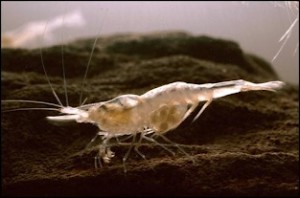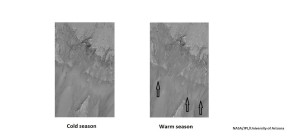
by: Nicole Willett
Astrobiology is a growing field in scientific research. It is the study of organisms that live under extreme conditions. These organisms are called extremophiles. Astrobiology encompasses many different sciences, including biology, astronomy, chemistry, and geology. One goal of astrobiology is to search for habitable environments outside of Earth, on planets such as Mars. Another is to find out how far to the extreme life can be pushed and still thrive. Not long ago, we had a very small definition of where and under what conditions life can exist. Since the implementation of Astrobiology into the world of true scientific research, we have redefined where life can flourish. The purpose of the rovers and landers on Mars has been to find evidence of past water and possible organic compounds. Astrobiologists are also looking for any evidence of prebiotic chemistry on Mars. By doing field research and laboratory studies on Earth, we can make comparisons to what we are currently finding on Mars. Our narrow definition of life from 20 to 30 years ago has been blown wide open.It is now known that life can exist under tremendously stressful conditions. There are many new terms for these organisms. Some of which are alkaliphile, halophile, radioresistant, polyextremophile, lithoautotroph, oligotroph, and cryophile. All of these organisms live in areas that are very far from the traditional areas where life was once believed to thrive. Previously we believed life needed sunlight, water, a food source, and to exist between 32oF (0oC) and 212oF (100oC).
 This narrow niche has changed to a very broad area. There have been organisms found living in deep caves completely without sunlight and thriving. One example of this is called the Kentucky cave shrimp. It is a blind and almost transparent troglobite shrimp. Also, several organisms, such as diatoms and algae, have been discovered living happily in the Arctic and Antarctic Sea ice. In addition, the bottom of the ocean contains hydrothermal vents that are under extreme pressure and high temperature. At these vents are entire ecosystems of extremophiles. They include millions of bacteria, several species of tube worms, shrimp, crabs, fish and many other organisms. The pH at the vents throughout the world have been measured to be as low as 2.8 (acidophile) and as high as 10 (alkaliphile). An alkaliphile lives in soil that has a high pH usually 9 or above. The results from the Phoenix Lander that studied the Martian soil in 2008 came back with a pH between 8 and 9. We know there are organisms on Earth that thrive in alkaline soil. One example is the Bacillus okhensis. This organism has been found on salt flats in India. It is also considered a halophile or salt tolerant bacterium. Halophiles can be found in environments with a salt content at least five times greater than ocean salinity. They are found in the Great Salt Lake in Utah, salt flats, and even in the Dead Sea.
This narrow niche has changed to a very broad area. There have been organisms found living in deep caves completely without sunlight and thriving. One example of this is called the Kentucky cave shrimp. It is a blind and almost transparent troglobite shrimp. Also, several organisms, such as diatoms and algae, have been discovered living happily in the Arctic and Antarctic Sea ice. In addition, the bottom of the ocean contains hydrothermal vents that are under extreme pressure and high temperature. At these vents are entire ecosystems of extremophiles. They include millions of bacteria, several species of tube worms, shrimp, crabs, fish and many other organisms. The pH at the vents throughout the world have been measured to be as low as 2.8 (acidophile) and as high as 10 (alkaliphile). An alkaliphile lives in soil that has a high pH usually 9 or above. The results from the Phoenix Lander that studied the Martian soil in 2008 came back with a pH between 8 and 9. We know there are organisms on Earth that thrive in alkaline soil. One example is the Bacillus okhensis. This organism has been found on salt flats in India. It is also considered a halophile or salt tolerant bacterium. Halophiles can be found in environments with a salt content at least five times greater than ocean salinity. They are found in the Great Salt Lake in Utah, salt flats, and even in the Dead Sea.
Deinococcus radiodurans
is a bacterium that is known to Astrobiologists as an extremely radiation resistant organism. A lethal dose of radiation for a human is 5 Gy (grey units). A typical medical x-ray is about 1 mGy (milli grey unit= 0.001 Gy). This hardy organism can resist a dose of 5,000 Gy wwith no loss of viability and 15,000 Gy with a 37% viability rate. Deinococcus has also been known to be resistant to cold, dehydration, the vacuum of space, and acidic environments. It is known as a polyextrmophile. A polyextremophile is an organism that possesses many different characteristics of extreme organisms.

Another example of a polyextremophile that is a more complex organism is the tardigrade, more commonly known as a water bear. These animals are amazingly resistant to almost anything nature sends its way. They are approximately 0.5 mm in length, with four stubby legs, and a slightly segmented chubby body. Water bears can be found just about anywhere one looks. They have been found from the Himalayas to 13,000 feet below the ocean and everywhere in between. The pressure differential is tremendous between these areas. Tardigrades can be heated to over 304
oF (150oC) and chilled to -328oF (-200oC) and survive. They have been taken to space, exposed to the vacuum and solar radiation, brought back to Earth, and survived. Water bears have the ability to resist exposure to 5,000 Gy of radiation. It has also been said, by some researchers that Tardigrades go into a state of chemobiosis to resist any environmental toxins that they are exposed to. How would we know if a water bear were on Mars? The Curiosity Rover has the ability to detect lipids that exist in the cell walls of organisms such as a tardigrade or any other microorganisms. This is possible even if the organism is in a state of suspended animation.
On November 28, 2012 it was widely reported that scientists had finally reached the salty water of Lake Vida in Antarctica. This lake has been isolated from the rest of the world for at least 2,800 years. The water in this lake has a salt content five times that of the ocean and is below the freezing point. Even with all of these extreme conditions, scientists discovered 32 species of bacteria. This number was higher than expected. Scientists are already comparing this find to what may potentially be found on Mars.
There are many other examples of extreme organisms that are fascinating and may seem alien to people. Astobiologists wish to use Earth analogues for their research. The goal is to find the limits of life, if there are any. This will help us to more readily recognize life when and if we find it on Mars or other bodies in the solar system. Our rovers are working diligently on Mars to help us find the answer to the question, “Is there life on Mars?”
On December 3rd, Curiosity Rover Scientists reported the latest findings on Mars. Curiosity has discovered chlorinated hydrocarbons in the soil. Included in these results are chloromethane (CH3Cl), dichloromethane (CH2Cl2), chloroform (CHCl3), and carbon tetrachloride (CCl4). Many of these are found naturally on Earth in marine organisms. However, the scientists at NASA have stated that these simple organics may not be indigenous to Mars. They may be contaminants from Earth, asteroids, meteors, or comets, or they may have formed as a result of the chemical reaction in the SAM instrument itself. Further tests will be performed to determine the nature of the simple organics. Another interesting find was that the percent of H2O in the soil was higher than expected. In addition there was deuterium (heavy water), sulfur, and chlorine in the soil. Sulfur is an essential element for all life on Earth. Please be aware that it is a large leap to go from simple organics to “life” on Mars. These results are still being verified and studied. ~Stay Tuned…….

Images [The Mars Society, pubs.usgs.gov, pbworks, NASA/JPL, (Secosky)]